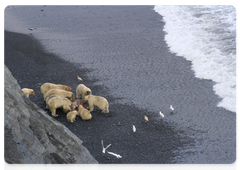MULTIMEDIA
 +
+
Polar bears eating a walrus on Wrangel Island. Although they hunt alone, polar bears usually share walrus carcasses. Such behaviour increases the chances of their survival and of the survival of the population as a whole in the harsh Arctic environment
 +
+
An adult polar bear on Vilkitsky Island near a walrus rookery. After feeding on a walrus, a polar bear’s face and head is bright red with blood. The blood washes off for the most part after entering the water, but the fur on their heads remains a yellowish-pink colour for several days. It is easy to spot a polar bear that recently fed
 +
+
Polar bear versus walrus. Walruses use their tusks to defend against polar bears if they have no time to retreat into the sea. Vigorous thrusts with the tusks and a forceful show of resistance are almost always enough to stop an attacking bear
 +
+
A young polar bear finds a walrus carcass. On Wrangel Island polar bears find walrus carcasses very quickly and leave nothing to waste. A polar bear that finds a dead walrus is usually shortly joined by others, as the wind spreads the smell fast
 +
+
Walruses group together before exiting the water. To reach a rookery, first walruses group together near the shoreline and watch the coast for polar bears for a long time. When they feel safe, the stronger adults start leaving the water. Their sounds attract all the other walruses in the area and the rookery starts to grow rapidly
 +
+
A walrus rookery on Wrangel Island. Walruses calmly lie close to each other until a polar bear approaches





 ABOUT THE PROGRAMME
ABOUT THE PROGRAMME
 POLAR BEAR RESEARCH: A HISTORY
POLAR BEAR RESEARCH: A HISTORY
 POLAR BEAR: LIFE, BEHAVIOUR AND MORE
POLAR BEAR: LIFE, BEHAVIOUR AND MORE
 VLADIMIR PUTIN'S VISIT
VLADIMIR PUTIN'S VISIT
 NEWS
NEWS
 MULTIMEDIA
MULTIMEDIA